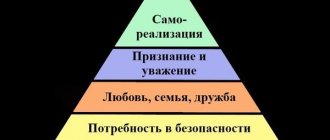Throughout life, a person performs many actions: eating, sleeping, working, raising children, listening to music, gaining knowledge. All these actions are aimed at achieving certain goals and satisfying needs. Let's find out what the needs are and briefly consider their most common classifications.
What are needs
The key word in defining the concept of need is “need”.
Need
- this is the need for certain things, objects of the material world, objects, people, social indicators, in the absence of which a person feels uncomfortable.
Taking into account this definition, neediness, in order to become a need, must meet the following criteria:
- A lack of need causes a feeling of dissatisfaction. A need is something desired, a good.
- Accompanying with emotions: from negative at the first stage to joyful after the need is fulfilled. When we really want something, we get nervous and anxious; when we get what we want, we relax.
- Fixation on the subject of need. Consciousness snatches from reality those things that can satisfy us. For example, if we are hungry, we will focus on the food and the smell of food.
The system of needs is also formed according to special rules:
- Need is common to all living beings on the planet. But the more developed the species, the higher the level of needs. The tree has enough nutrients from the soil, sunlight, and rain watering. Man, as a highly developed animal, needs much more.
- The older the person, the more extensive the list of what is required. A baby can do without things that an adult needs.
- Needs are a strictly hierarchical structure, some are primary, others are secondary.
People's actions are dictated by the presence of a certain need, which is the main motivator of activity. Motivation to get what you want moves a person forward and forces him to act. Everything that has been created by people throughout the history of mankind in politics, economics, art, science is the result of activities to satisfy needs.
The inability to fulfill needs can lead to dependence on their importance for the individual and to the following various consequences:
- Physical death of a person
. If the need for food, sleep, water, air, safety, etc. is not satisfied. - Frustration
is a long-term experience associated with a nervous disorder and can lead to serious psychological problems. An example is the lack of recognition of a person’s merits by society. - Sublimation
- the transition of the energy of dissatisfaction into creation, creativity. For example, the absence of sex is replaced by heavy sports activities.
Thus, needs should be listened to and efforts should be made to realize them.
Needs and motives of the individual
The main condition for the life of organisms is the presence of their activity. In animals, activity manifests itself in instincts. But human behavior is much more complex and is determined by the presence of two factors: regulatory and incentive, i.e. motives and needs.
The motives and system of needs of the individual have their own main characteristics. If need is need (scarcity), the need for something and the need to eliminate something that is in abundance, then the motive is a pusher. Those. need creates a state of activity, and motive gives it direction, pushes activity in the required direction. Necessity or necessity, first of all, is felt by a person as a state of tension inside, or manifests itself as thoughts, dreams. This encourages the individual to search for an item of need, but does not give direction to the activity to satisfy it.
Motive, in turn, is an incentive to achieve the desired or, conversely, to avoid it, to carry out an activity or not. Motives can be accompanied by positive or negative emotions. Satisfying needs always leads to a release of tension; the need disappears, but after a while it can arise again. With motives, the opposite is true. The stated goal and the immediate motive do not coincide. Because a goal is where or what a person strives for, and a motive is the reason why he strives.
You can set a goal for yourself following different motives. But an option is also possible in which the motive shifts to the goal. This means transforming the motive of activity directly into a motive. For example, a student initially learns his homework because his parents force him to, but then interest awakens and he begins to study for the sake of learning itself. Those. It turns out that a motive is an internal psychological motivator of behavior or actions, which is stable and encourages an individual to carry out activities, giving it meaning. And need is an internal state of feeling need, which expresses the dependence of a person or animals on certain conditions of existence.
What needs does a person have?
Man is one of the representatives of the animal world, with instincts and needs inherent in other species. At the same time, we have higher intelligence, feelings, and strong-willed qualities. This combination causes the presence of needs at two levels: basic and additional (primary and secondary).
Basic Needs
This group is vital for humans as a biological species. Basic needs are divided into two groups.
| Physiological | Existential |
| Breathing, nutrition, thirst, sleep, rest, procreation, housing. | Comfort, social and legal security, availability of employment, etc. |
Physiological basic needs must be satisfied first, since without them existence itself is impossible. The listed things and phenomena have been inherent in man since primitive times.
A person tries to make the process of satisfying basic needs more comfortable. If at the initial stage of the development of the human race animal skins served as clothing, today a whole industry is working to clothe us.
Basic needs can change with age in favor of the predominance of some over others. Sleep, for example, is more important for young children and older people, but in our youth we are able to get by with minimal hours of rest and still feel alert. Sex, as a primary need, can also, for a number of reasons, lose priority with age, but in adolescence it is a priority.
Questions often arise about security as a necessity for existence. Man has always experienced danger from phenomena in the surrounding world or from other people. A tsunami, a collapse of glaciers, an attack by wild animals or other tribes - all this forced a person to defend himself or run away. Over time, entire institutions were formed that were supposed to protect the individual from external incursions (army, police, Ministry of Emergency Situations). That is why safety is a primary need; we must understand that our lives and property are protected and protected.
The needs of existence (existence) appear as an individual grows up and determines his place in society.
Secondary needs
If a group of primary needs is necessary for survival and is laid down at the genetic level, then secondary needs determine a certain level of a person’s quality of life and come and are transformed with life experience.
Among the secondary needs in theory, the following are identified:
- Spiritual
. These include the need to obtain new knowledge about the world, the search for the meaning of life and one’s place in it, the development of creative abilities, and the desire for harmony. - Social
– love, friendship, interaction with other people, feeling part of society, a separate social group (class, work team, family). - Prestigious
. We are talking about the need for recognition of our successes, worthy self-esteem, respect from other members of the communities in which we belong.
Thus, primary needs are innate and determined by physiology, while secondary needs are psychological in nature and develop throughout life.
Types of needs
Needs can be classified on various grounds, of which there are quite a lot in the theory of psychology. The main types of division of needs are presented in the next section.
If we summarize all available theories, then we should distinguish three basic types of human needs.
Biological or physiological
Among the innate human needs laid down at the genetic level are the following:
- Food safety and taste characteristics.
- Comfortable external temperature and electromagnetic background.
- Clean water suitable for quenching thirst.
- Healthy ecology.
- Safety of life and home.
- Sexual satisfaction.
- Disposal of waste products.
These things are necessary for any living creature. This set of needs has practically not changed since the creation of the world, since from a physiological point of view, we are the same as millions of years ago. A person strives to realize them first and foremost and immediately.
Spiritual
Existential needs come from a system of universal human spiritual values, including: beauty, mercy, tranquility, harmony, peace, art. Each person has their own spiritual needs (as opposed to biological ones) and change over time and experience.
Among the spiritual needs are the following:
- The need for knowledge
. A mature person understands that in order to further grow, he must constantly learn. Moreover, expand the boundaries of existing skills and acquire new ones. People enter educational institutions to receive additional education, take advanced training courses, master new professions, and master the basics of painting and music. - The need for constant work on oneself, improving one’s personality (self-improvement)
. By satisfying this need, we quit smoking, go on a diet, get rid of toxic people and harmful emotions. A person thinks about how he would like to see himself after a certain period of time and strives for this. - The need for love and personal happiness
. The vast majority of people dream of having a loved one of the opposite sex nearby and creating a stable family. Many have been searching for many years, this need is so strong.
The realization of spiritual needs can be carried out through the simplest things. For example, a person goes into nature and sits with a fishing rod, fishing. At this time, he reflects, calms down, acquires spiritual harmony, satisfying his need for peace and making plans for the future.
Social
This type of needs is aimed at understanding one’s place in society and is associated with groups of people, social and economic activity.
Examples of social needs:
- Personal identification
. A person positions himself as a part of society with common traits inherent in society or a separate group. At the same time, he recognizes himself as an individual unit with a set of specific qualities and characteristics. - Self-affirmation
. We want to be satisfied with ourselves, with the actions and deeds that we perform. It is also important for a person to feel significant in society, to enjoy respect and approval from other people.
- Altruistic aspirations
. The individual takes pride in actions aimed at helping and assisting other people or living beings. He needs to be needed, useful, even in conditions of abandoning his own interests.
All of these types of needs are interpenetrating, they complement each other, some follow from others. For example, having satisfied the spiritual need to acquire a profession, we strive to achieve success in work for which we will be praised, and this is already a social need.
Motivation and personality needs
The motivational processes of an individual are aimed at achieving or, conversely, avoiding set goals, implementing certain activities or not. Such processes are accompanied by various emotions, both positive and negative, for example, joy, fear. Also during such processes some psychophysiological tension appears. This means that motivational processes are accompanied by a state of excitement or agitation, and a feeling of decline or surge of strength may also appear.
On the one hand, the regulation of mental processes that affect the direction of activity and the amount of energy needed to perform this very activity is called motivation. On the other hand, motivation is still a certain set of motives that gives direction to activity and the most internal process of motivation. Motivational processes directly explain the choice between different options for action, but which have equally attractive goals. It is motivation that influences the perseverance and perseverance with which an individual achieves his goals and overcomes obstacles.
A logical explanation of the reasons for actions or behavior is called motivation. Motivation may differ from real motives or be deliberately used to disguise them.
Motivation is quite closely related to the needs and requirements of the individual, because it appears when desires (needs) or a lack of something arise. Motivation is the initial stage of an individual’s physical and mental activity. Those. it represents a certain incentive to perform actions by a certain motive or process of choosing reasons for a particular direction of activity.
It should always be taken into account that completely different reasons may lie behind completely similar, at first glance, actions or actions of a subject, i.e. Their motivation may be completely different.
Motivation can be external (extrinsic) or internal (intrinsic). The first is not related to the content of a specific activity, but is determined by external conditions relative to the subject. The second is directly related to the content of the activity process. There is also a distinction between negative and positive motivation. Motivation based on positive messages is called positive. And motivation, the basis of which is negative messages, is called negative. For example, a positive motivation would be “if I behave well, they will buy me ice cream,” a negative motivation would be “if I behave well, they will not punish me.”
Motivation can be individual, i.e. aimed at maintaining the constancy of the internal environment of one’s body. For example, avoidance of pain, thirst, desire to maintain optimal temperature, hunger, etc. It can also be a group one. This includes caring for children, searching and choosing one’s place in the social hierarchy, etc. Cognitive motivational processes include various play activities and research.
Classifications of needs
Theoretical psychology offers many classifications of needs. We have already discussed one of them above: physiological, social and spiritual, these are the main groups of needs.
Foreign researchers did not so much classify needs as offer a specific list of them.
Examples:
- G. Murray
- achievements, aggression, independence, sex, creativity, understanding, respect, self-knowledge. - A. Pieron
- novelty, hedonism, communication, competition, mutual assistance and others (more than 20 types in total); - E. Fromm
- significance, self-affirmation, communication, affection, self-identification.
Some scientists have identified so-called neurotic needs as a separate group, the lack of satisfaction of which can lead to mental illness. These include: lack of social and interpersonal justice, the need for support and empathy, recognition, and possession.
In Russia, a classification of needs has been adopted, which divides them into the following levels:
- Based on the nature of the emergence of needs - natural and cultural
. - Depending on the area of application - communicative
(communication with other people),
cognitive
(the need to acquire new knowledge),
labor needs
, etc. - In relation to the object to which the need is directed - biological, material, spiritual and social
. - Correlating to their origin - endogenous
(determined by internal factors) and
exogenous
(depending on external conditions).
As we see, the number of human needs is numerous; today there is no complete list of them; there are only generalized groups and types. The most famous theory that places all types of human needs in order of priority is Abraham Maslow's Hierarchy of Needs.
The psychologist drew a whole pyramid, where needs are indicated in ascending order. This is what she looks like.
Maslow assured that until a person has satisfied the needs of the widest part of the pyramid, he will not strive to receive benefits from the higher levels. For example, if a person is hungry, then he has no time for public recognition. He considered hunger not only in relation to food, but also to sleep, thirst, sex, etc.
Maslow’s rule does not work in the opposite direction: an individual who has fulfilled the need for respect and recognition still needs food and sleep.
Definition of the concept
Need is the need for certain things, material objects, spiritual components, and communication with people. In the absence of these components, a person feels uncomfortable.
A need can turn into a need only if it has certain signs:
- its deficiency causes a feeling of dissatisfaction;
- negative emotions are replaced by positive ones;
- consciousness is fixed on the object of need.
If a person does not have the desired item, then he suffers from negative emotions. When he gets what he needs, his mood improves. Depending on the needs of the body, attention will be fixed on this particular object. For example, if you feel hungry, then all your thoughts will be only about food.
Needs are inherent in all living beings on the planet. But the more developed it is, the more it needs. And also their number depends on age. A baby needs much fewer things than an old man. Necessity forces people to act. Everything they created in their lives was dictated by her.
Formation of human needs
Taking into account the considered classification of needs, we can talk about the features of their formation. Basic physiological needs are innate, transmitted to us at the genetic level. A person lives with them until his death; without receiving them, he dies physically.
Such needs cannot be prohibited or imposed by force. Primary needs cannot be good or bad, pure or dirty. Only ways and methods of satisfying them can be considered unworthy. For example, a person uses a public space instead of a toilet.
Primary spiritual needs also appear with a person. The presence of love, close people, harmony, and self-realization in life are mandatory for his mental health. Of course, without the listed benefits, a person will not die, but he will be stuck in reflection and frustration for a long time.
Secondary needs are formed in an individual in several stages.
Infancy
All the physiological needs of the baby are provided by his parents. Since the child has contact with adults, social needs arise even before six months: he smiles, looks at rattles, identifies mother and father.
Earlier childhood
At about the age of 3 years, the baby develops an understanding of objects to satisfy needs - he realizes the need for toys, certain food, specific clothing. Cognitive needs grow, the child reads books, sculpts, draws, and actively explores the world.
Preschool period, primary school age
Children's social environment expands significantly. In addition to mothers and grandmothers, they have their own friends - children from kindergarten, class, yard or clubs where he begins to go. The need for communication, recognition, mutual assistance and understanding is formed.
Teenagers
At this age, the last physiological need is revealed - sexual. For the first time, such secondary needs as self-realization and self-improvement are formed. There is a sharp change and expansion of cognitive interests. A teenager strives to learn about those things and objects that he did not even think about in the early periods of his life.
On the basis of the formed sexual need, a need for a person of the opposite sex and romantic experiences appear. The need for communication is shifting towards peers and friends. Relatives fade into the background.
It is believed that by the end of adolescence, all the basic needs of a person have already been developed. Their further development occurs through changes in their content and methods of achievement.











